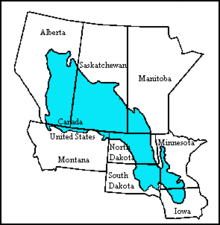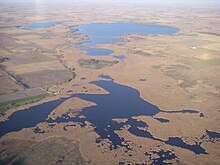The Prairie Pothole Region (PPR; French: Région des cuvettes/fondrières des prairies) is an expansive area of the northern Great Plains that contains thousands of shallow wetlands known as potholes. These potholes are the result of glacier activity in the Wisconsin glaciation, which ended about 10,000 years ago. The decaying ice sheet left behind depressions formed by the uneven deposition of till in ground moraines. These depressions are called potholes, glacial potholes, kettles, or kettle lakes. They fill with water in the spring, creating wetlands, which range in duration from temporary to semi-permanent.[1] The region covers an area of about 800,000 sq. km and expands across three Canadian provinces (Saskatchewan, Manitoba, and Alberta) and five U.S. states (Minnesota, Iowa, North and South Dakota, and Montana). The hydrology of the wetlands is variable, which results in long term productivity and biodiversity. The PPR is a prime spot during breeding and nesting season for millions of migrating waterfowl.[2]


Hydrology
editFew natural surface water drainage systems occur in the region as pothole wetlands are not connected by surface streams. They receive most of their water from spring snowmelt and precipitation.[3] Some pothole wetlands also receive groundwater inflow, so they typically last longer each year than those that only receive water from precipitation. Shorter-duration wetlands fed only by precipitation typically are sources of groundwater recharge.[4] The hydrology of the potholes is very variable, responding to changes in precipitation and groundwater, and results in regular wet-and-dry cycles.[5]
Vegetation
editThe vegetation of the PPR consists of emergent plants and tall grasses, while the prairie surrounding the region has dense grassland vegetation. The composition of a local plant community is heavily affected by the amount of water available. In wetter wetlands that retain water through the summer, the common plant is hard-stem bulrush, along with soft-stem bulrush and common threesquare in slightly drier regions of the wetlands. The vegetation in permanently flooded wetlands is more aquatic; duckweeds, pondweeds, aquatic buttercups, and aquatic smartweeds are some of the most common. In drier wetlands of the PPR, the vegetation varies from spikerush, which is found in the wetter areas of the wetland, to foxtail barley and wheatgrass on the outer edges of the wetland.[6] The variable availability of water in the Prairie Pothole Region is buffered by an abundant seed bank under the soil, comprising species that thrive under different water regimes. During times of drought, shortgrass species increase and expand their range, while during wetter periods, tallgrass and mixed prairie communities become more common.[7]
Wildlife
editThe Prairie Pothole Region provides important habitats for migratory waterfowl and other wildlife, supporting more than 50% of North America's migratory waterfowl.[8] In particular, the region is one of North America's most important breeding areas for ducks. Although the region contains only about one-tenth of the continent's habitat area for breeding of waterfowl, roughly half the primary species of game ducks on the continent breed there. The region accounts for more than 60% of the breeding populations of mallard, gadwall, blue-winged teal, northern shoveler, northern pintail, redhead, and canvasback ducks.[9]
Threats
editConversion of land for agriculture is a significant factor in the loss of wetlands in the PPR. More than half of the wetlands have been drained for farming.[4][8] In particular, 90% of the prairie wetlands of the Minnesota River basin have been lost as habitat.[10] The wetlands that do persist, surrounded as they are by agricultural lands, are also affected. Chemical runoff, sedimentation, and nutrient flow into the wetlands have adverse impacts.[11]
Climate change is an adverse factor in the long-term viability of PPR wetlands for breeding ducks and other birds. Without mitigation, severe droughts and rising temperatures will cause many pothole wetlands to dry up sooner in the spring. In turn, due to the timing of waterfowl migrations, these dried wetlands will not present suitable breeding habitat. Warming-related drought may affect as much as 90 percent of the PPR's remaining wetlands.[11] Simulations suggest that climate change will shift the most productive wetlands from the center of the region (southeastern Saskatchewan and the Dakotas) to edges of the PPR in the east and north.[1] However, research has suggested that the effect of global warming is overshadowed by that of intensified land use and drainage of wetlands.[12]
See also
editReferences
edit- ^ a b Johnson, W. Carter; Millet, Bruce V.; Gilmanov, Tagir; Voldseth, Richard A.; Guntenspergen, Glenn R.; Naugle, David E. (2005). "Vulnerability of Northern Prairie Wetlands to Climate Change". BioScience. 55 (10): 863. doi:10.1641/0006-3568(2005)055[0863:vonpwt]2.0.co;2. ISSN 0006-3568.
- ^ "Prairie Pothole Region". www.ducks.org. Retrieved 2019-11-13.
- ^ "Comprehensive Report Ecological System - Great Plains Prairie Pothole". explorer.natureserve.org. Retrieved 2019-12-02.
- ^ a b Euliss, Ned H. Jr.; Wrubleski, Dale A.; Muchet, David M. (1999). "Wetlands of the Prairie Pothole Region: Invertebrate species composition, ecology, and management". In Batzer, Darold P.; Rader, Russell B.; Wissinger, Scott A. (eds.). Invertebrates in freshwater wetlands of North America: Ecology and management. John Wiley and Sons. pp. 471–514. ISBN 978-0-471-29258-6. Retrieved 22 November 2019.
- ^ Mitsch, William; Gosselink, James (2015). Wetlands (5th ed.). Hoboken, New Jersey: Wiley. pp. 61–62. ISBN 978-1-118-67682-0.
- ^ Montana Natural Heritage Program. "Great Plains Prairie Pothole". Montana Field Guide. Retrieved 19 October 2020.
- ^ Anderson, Jim; Samargo, Emily. "Wetland Types: Prairie Potholes". Wetlands Management. Archived from the original on 28 November 2012. Retrieved 19 October 2020.
- ^ a b "Regional Ecosystems: The Prairie Pothole Region". National Biological Information Infrastructure. Archived from the original on 25 October 2011. Retrieved 26 October 2020.
- ^ Austin, Jane E. (3 August 2006). "Waterfowl in the Prairie Pothole Region". Northern Prairie Wildlife Research Center. United States Geological Survey. Archived from the original on 29 June 2011. Retrieved 26 October 2020.
- ^ "Wetlands". Fact Sheets. Minnesota River Basin Data Center, Minnesota State University, Mankato. 15 April 2011. Retrieved 26 October 2020.
- ^ a b "Prairie Potholes". National Wildlife Federation. Retrieved 26 October 2020.
- ^ Niemuth, Neal D.; Fleming, Kathleen K.; Reynolds, Ronald E. (2014-06-17). "Waterfowl Conservation in the US Prairie Pothole Region: Confronting the Complexities of Climate Change". PLOS ONE. 9 (6): e100034. Bibcode:2014PLoSO...9j0034N. doi:10.1371/journal.pone.0100034. ISSN 1932-6203. PMC 4061047. PMID 24937641.
External links
edit- "The Small Wetlands Program: A Half Century of Conserving Prairie Habitat". National Wildlife Refuge System. U.S. Fish & Wildlife Service. Retrieved 9 July 2018.
- "Welcome to the Prairie Pothole Joint Venture". Prairie Pothole Joint Venture. Retrieved 9 July 2018.
- "Prairie Potholes". Wetlands. United States Environmental Protection Agency. 2016-10-06. Retrieved 2018-07-09.
- America’s Grasslands: A Threatened National Treasure Documentary produced by Prairie Public Television
- Land-use Change, Economics, and Rural Well-being in the Prairie Pothole Region of the United States United States Geological Survey